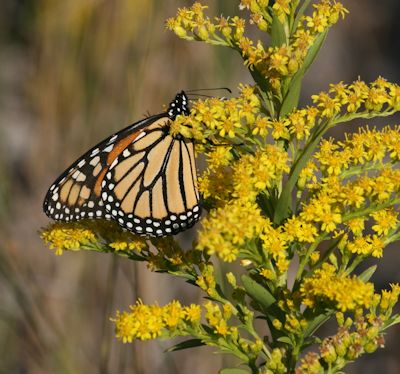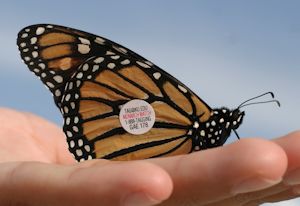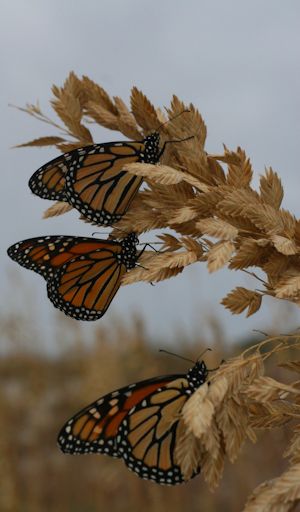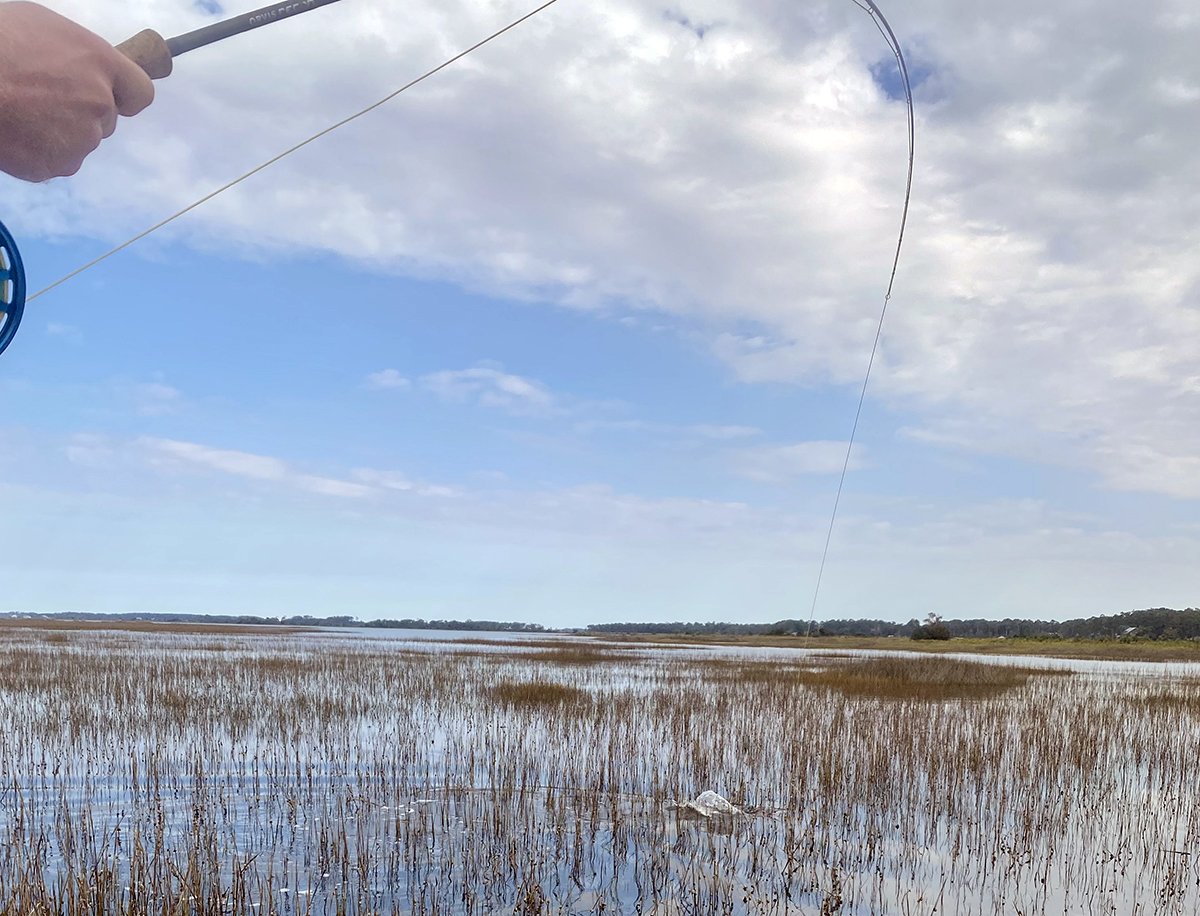 A monarch butterfly sips on the nectar of a goldenrod to fatten up before setting off on a long migration to Mexico. Photo: Sam Bland. |
A welcomed high-pressure system dropped down from the north a couple of weeks ago and brought cooler air to represent the arrival of fall. Along the way, the wind corralled a bunch of monarch butterflies and gave them a breeze to ride on as they began their annual migration.
While out on a bicycle ride that morning, I counted hundreds of these butterflies decked out in their Halloween colors of orange and black. The day before I only saw one monarch. They fluttered along and provided some butterfly diversity as they mingled with the yellow cloudless sulfurs and orange gulf fritillaries seeking out nectar from the new goldenrod blooms.
Supporter Spotlight
The monarchs will slurp up nectar using their long proboscis to fatten up and actually gain weight as they make their way to wintering grounds high in the mountain forests of central Mexico. It is thought that taking advantage of the wind currents during migration allows the Monarch to conserve fat supplies that will be crucial to survival as they endure the winter. Monarchs east of the Rocky Mountains will head to Mexico and those west of the Rockies will winter in southern California.
Two factors require monarchs to migrate: They cannot tolerate freezing temperatures and their host plant, milkweed, is not available year round.
Due to the magnitude of their annual migration, monarchs are dispersed from northern Mexico to southern Canada and they inhabit almost all of North America and are found in other parts of the world as well. This wide range of distribution earned it the name monarch. Entomologist Samuel Scudder was the first to document the name in 1847, because as he put it, “it is one of the largest of our butterflies, and rules a vast domain.” The monarch was also called King Billy by settlers in honor of King William III of England.
It takes four generations of monarchs to complete the annual migration. In the spring, the monarchs that overwintered in Mexico will head north and the females will search out their host plant, milkweed, to lay eggs on one at a time. When they land on a plant they will use their legs to scratch the plant and chemoreceptors will taste the plant juices to confirm that it is the correct plant. This egg will produce a caterpillar that will feed on the milkweed plant which contains a secret weapon against predators. By eating the milkweed, the caterpillar and subsequent adult butterfly have a chemical called cardenolide in their bodies. When predators such as birds, frogs and lizards eat a monarch, they get sick and usually throw up. This experience is bad enough that they remember the bright orange and black colors and avoid targeting the monarch for a meal.
 Tagging butterflies helps determine where they came from. Photo: Sam Bland. |
The first three generations travel northward and each generation lives only about six weeks. By then they are dispersed well into northern areas, and the fourth generation of adult monarchs are crawling out of their chrysalis in late summer. This generation will not mate until spring after they have migrated and survived the winter. Unlike the first three generations, the final generation can live up to eight months.
Supporter Spotlight
Following ancient instinctual urgings, the monarch’s southward march is triggered by dropping temperatures and shorter daytime hours. During their migratory journey, a number of these insects will be captured and fitted with a tag to help unlock some of their mysteries. A research program known as Monarch Watch, under the direction of the University of Kansas, uses volunteers, teaches, researchers and students to collect data to learn details of their southward movement.
On a number of occasions, I have been one of the people trying to snag these slippery elusive butterflies. I can testify that few things can make you feel and look more foolish than trying to net a butterfly that seems to be toying with you. You must be able to run with the direction of a squirrel on a roadway during rush hour while swinging a net at imaginary ghosts. Most of my netting attempts captured only air. After miraculously netting one of the butterflies, I would carefully remove it from the net and hope that it would not escape from my gentle grasp. I would take note of the butterfly’s sex — the male has two obvious black “pouches” on the dorsal side of their hindwing — and then apply the tag.
Now when I tell people that I have tagged butterflies, they laugh, thinking that I’m joking. I assume that their imagination immediately visualizes a heavy metal band on their thin wispy leg that would weigh it down like a bowling ball. The tag is actually a small all-weather ultra-light decal that is applied, or stuck, on the ventral side of their hindwing. The decal has a unique six symbol code of letters and numbers as well as reporting information. As the tagged butterflies make their way to Mexico and eventually reach their special overwintering site, they will be observed or found dead. Hopefully the person who observes or recovers the tag code will report it to Monarch Watch. This information is used to help determine mortality and thus, population trends. The data is also scrutinized by researchers to learn more about their navigation, the migratory corridors that they use and the impacts of weather.
 Monarchs cling to sea oats behind sand dunes. Photo: Sam Bland. |
For many years, the location of their wintering site was a mystery. Then in the 1970’s biologists found them in the misty transvolcanic mountains of Mexico, hanging by the millions in a small section of oyamel fir trees. Why here? Well this spot has all the essential elements that allow them to survive. At close to 10,000 feet, the site is cool enough, without freezing, that the monarchs do not metabolize and, thus, conserve their fat reserves. The forest is frequently covered in clouds and fog which keep the insects moist and provides water to drink. Finally, the surrounding forest forms a protective buffer from high winds during storms. This site, known as the Monarch Butterfly Biosphere Reserve, is so special that it has been designated as a World Heritage Site to protect the 60 million to one billion monarchs that spend the winter there.
One of my most successful outings tagging monarchs was on a late October day after a cold front passed through leaving a chilly layer of 50 degree air over the barrier islands. I went to one of my favorite monarch sites, a sand dune covered in a blanket of sea oats and goldenrod. The cool air had grounded an entire fleet of these cold-blooded insects, hundreds of them clinging to the vegetation like Christmas tree ornaments. Without a net, I easily plucked them off, applied the tag and gingerly placed them back. Once, under the hazy influence of “monarch-xide,” I jumped off the tailgate of a moving pickup truck to capture a monarch that had already been tagged. This butterfly had traveled from Cape May Point, N. J. to Bear Island along our coast in eight days, averaging 40 miles a day.
Monarch Watch has started a number of programs to help monarchs overcome their vulnerability to insecticides, herbicides and loss of habitat. Their Monarch Waystation and Bring Back the Monarch programs create fields of milkweed and flowering habitat at schools, public lands and residential landscaping.
It may not be as spectacular as thousands of thundering hooves of wildebeest pounding over the Masai Mara, but the fall migration of the monarch is one of the world’s greatest wildlife spectacles. These tiny insects will fly over two thousand miles and as they begin to reach their final destination, groups will merge together and form into great clouds of butterflies.
How they locate their wintering grounds is not really known. Scientists speculate about magnetic fields, sun orientation, a chemical compass and a sun clock in their antennae.
As they settle in on the fir trees to take their rest, the local cultures celebrate their arrival of the monarch which coincides with the Day of the Dead or Dia de los Muertos holiday. It is believed that monarchs represent the souls of ancestors coming back to earth for a visit.







